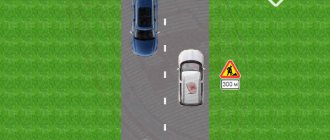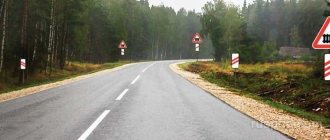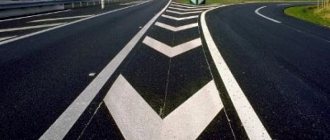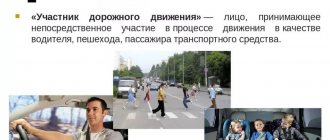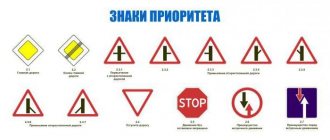New traffic signs 2021 have generated lively discussion online, especially one prohibiting the movement of buses (similar to sign 3.4 prohibiting the passage of trucks), which they plan to install on the roads of large cities to relieve congestion on highways. What innovations did legislators “please” motorists with?
Major changes
Some road signs have undergone amendments to the rules. Major fixes:
- Limiting the movement of cyclists;
- Prohibition on entering a limited area without a pass;
- Several familiar signs will disappear from the road;
- Limiting the movement of equipment with large emissions of harmful substances;
- Areas adjacent to diplomatic missions will be specially designated;
- Intersections will become clearer thanks to traffic regulations during traffic jams;
- Paid parking will be marked with a blue line;
New road signs will appear:
| Number and name | Image | Number and name | Image |
| 1.35 "Crossroads Section" | 3.34 “Bus traffic is prohibited” | ||
| 5.14.2 "Lane for cyclists" | 5.14.4 "End of lane for cyclists" | ||
| 5.39 "Bicycle zone" | 5.40 “End of the bicycle zone” | ||
| 7.14.1 “Customs control point” | 8.9.3 “Parking for diplomatic vehicles only” | ||
| 8.25 “Ecological class of the vehicle” | 8.26 “Charging electric vehicles” |
Coverage area
The parking perimeter is marked with appropriate signs, which helps to avoid misinterpretation or fraudulent actions, both on the part of parking lot owners and third parties.
The rules for such cases contain special signs that limit the perimeter and movement along it by distance and direction. Additionally, signs are installed specifying the method of parking the vehicle and the duration of parking. Signs of this type are installed only if they are required by local parking regulations. The placement of signs is regulated by clause 8 of the traffic rules.
Sometimes in parking lots there are no other signs or instructions other than the paid parking sign. In such scenarios, road markings should be taken as a normative basis. That is, the services of a particular zone cease to be paid upon crossing the next intersection or 5 meters before it.
When there is only one sign “10, 15, 20” on the road, you can park your car in front of it, if it does not contradict other rules. In this case, no one has the right to take money for parking a vehicle, and without regard to the duration of parking.
Signs contain information about the coverage area, types of permitted vehicles
Similar rules apply in residential areas, but only if the developer has not designated paid infrastructure. Naturally, the latter should not infringe on the rights of those living in this territory, nor should it contradict the law. In other cases, there is no need to pay for parking in courtyards and other local areas: zones of such a plan are legally designated for the vehicles of residents and their guests.
Rules for moving heavy vehicles
For equipment weighing more than 3.5 tons and above, a new sign is introduced that limits the size of vehicles with a weight control zone. There will be two types of signs - a regular one, marking the control zone, and a crossed out one, marking the end of the control zone. In areas where such a road sign will be installed, heavy vehicles will be prohibited from:
- Stop on the side of the road;
- Travel with dirty or missing registration plates;
- Stopping and turning around are also prohibited;
- Using powerful searchlights or spotlights.
In the area covered by the sign, you must maintain a distance of at least 20 meters from the nearest vehicle, observe the speed limit and move in your own lane.
Bicycle and pedestrian zones
Separately, signs indicating the purpose of sections of urban infrastructure existed until recently, however, if we talk about entire zones, for example, Spasskaya Street from Lenin to Kazanskaya, then there were no such signs in the traffic rules. What can we say about combined ones, allowing people to ride bicycles in pedestrian areas.
It is important to understand that the adopted standard is a standard parallel to GOST, and not a mandatory document. That is, when changing or installing new signs, for example, in Kirov or other cities, the authorities can rely on the requirements of GOST, or they can be guided by the accepted standard. This is legal and the choice of what to rely on remains with the authorities. Whether they take modern criteria into account or prefer to act in the old-fashioned way will show their attitude towards the desire to develop a comfortable urban environment for residents and guests of the city.
Photo: Probok.net
Addition to 2021 edits
Road signs for which the images have changed
| Number and name | Old look | The new kind |
| 5.35 “Zone with restrictions on the environmental class of motor vehicles” * | ||
| 5.36 “End of the zone with restrictions on the environmental class of motor vehicles” * | ||
| 5.37 “Zone with limited environmental class by type of vehicle” * | ||
| 5.38 “End of the zone with limited environmental class by type of vehicle” * | ||
| 6.4 “Parking (parking space)” | ||
| 7.21 “Gas station with the ability to charge electric vehicles” | ||
| 8.4.3.1 “Type of vehicle” | ||
| 8.4.15 “Except for the type of vehicle” | ||
| 8.9.2 “By parking permits” * | ||
| 8.9.4 “No parking permits” * |
In 2021, new restrictive signs for cars with different environmental classes appeared in the Russian Federation. This year 5 more signs will be introduced. They will restrict the movement of cars and other vehicles in the marked area that do not comply with the environmental class indicated on the sign.
New signs will make it possible to restrict the entry and passage of vehicles with a low environmental class into the marked areas. The new rules also apply to parking; they prohibit drivers from stopping their vehicle if it does not comply with the standards. If previously such signs were valid for cars that had an environmental class specified in their documents, then from 2021 these rules will apply to any vehicle. The rules are already spelled out in the traffic rules. For this violation, a fine of 500 rubles is imposed.
Learn the materiel!
The most important of the new road signs for 2021 are those that indicate prohibition. They complement and expand the existing rule signaling system for all road users. In addition, the list of warning and restrictive signs has been expanded.
Stop/parking
Don’t be surprised when you see on the road, buildings, lamp posts or fences not just a blue circle with one or two lines intersecting it, but an analogue of a sign prohibiting stopping and parking, complemented by compact arrows. These are additional signs prohibiting stopping or parking, with arrows indicating their area of influence.
Just go back!
The list of new road signs in 2021 was supplemented by signs that are fixed on sections of roads and intersections where only reverse traffic is allowed, and all other methods are prohibited.
True, in discussions on many automobile forums, drivers were unable to recall from their experience an encounter with such an intersection.
The tram will start...
In order for city trams to move better and faster, providing the population with better services, a new sign has been developed - a square with a blue background, along which a tram car rushes along narrow rails, and at the top its path is indicated by a bright white arrow.
Although at the moment the sign has not been added to the traffic rules and its installation is not mandatory, it is assumed that its appearance on the road will mean a ban on driving onto the railway tracks along which urban transport moves.
Change your lane, boss!
Another innovation again concerns the sphere of public transport. We have seen the blue squares on which the bus moves before, but now there is a large arrow drawn above the roof of the bus, indicating one of the possible maneuver options - right, left, turn with a U-turn.
They plan to use this sign in front of the intersection to designate a lane when buses, minibuses and taxis cannot continue direct traffic along it. The arrows indicate exactly what the driver should do - change lanes to the left or right, or additionally complete such a maneuver by turning in the opposite direction.
On a note! Passengers will now be able to see new stop signs: a square with a bus on a blue and white background at the bottom, complemented by a description of the route.
Read by stripes!
The number of new road signs has increased since January 2021, which regulate traffic in lanes. This type of signs is available in a variety of designs. For example, the left and center lanes are only straight ahead, while the right lane is only allowed for public transport and only straight ahead. Or the right lane - only go straight, the central lane - turn left, the left lane is allocated for tram tracks.
In general, the “filling” of additional lane movement indicators is based on well-studied traffic signs, so reading the new variations will not be difficult.
At the same time, a whole series of separate signs have been developed for the correct movement along the lanes, which are attached above each of the lanes separately. The only danger is that in case of forgetfulness, failure to install one of the signs or a conflict between their contents, a collapse will begin on the road.
The usual sign 5-15-3, indicating the appearance of an additional acceleration lane, was supplemented by colleagues with the index “d”. They indicate the appearance of special lanes for U-turns, and if there is a white circle with a red border, they limit the maximum permissible speed in a specific lane.
Parallel!
In addition to the old priority signs 2-1 and 2-4, signs have been created to tell the driver about the rules that should be followed when changing lanes onto a parallel roadway.
It’s nice that the signs are easy to read, because they are based on well-known signs – main road, give way, etc.
Crosswalk
The increase in fines for not allowing pedestrians to pass probably forced legislators to work on improving the familiar little man running along a zebra crossing from childhood. A yellow luminescent outline has been added to the standard look of a blue square on a white triangle.
Such signs are already installed on unregulated sections of the road, especially near children's institutions, poorly lit and limited visibility areas. It is important that the size of the frame is determined by the standard - no more than 15% of the sign area, which undoubtedly deprives the sign of its resemblance to an advertising sign.
Although more than two years have passed since diagonal pedestrian crossings appeared in traffic regulations, this type was not designated on the roads. All the nimble old ladies, boys with bicycles and mothers with strollers are rejoicing, because now there is a sign that allows pedestrians to cross the roadway after the green traffic light turns on diagonally.
Go right, but give way!
A useful sign that can partially reduce the length of traffic jams and reduce the number of accidents, while its effectiveness is highly appreciated by experts. A green arrow in a black square with an explanatory inscription is fixed to the right of the traffic light at the level of the red and yellow sections. It allows you to ignore traffic lights and turn right after giving other drivers the right of way.
More parking – good and different!
All drivers are familiar with the parking lot designation – on a blue square there is a white letter “P” (or rather, the English “pi”). But there shouldn’t be any problems reading the new pointers:
- the typographic symbol of the Russian ruble logically means a paid parking zone;
- “P” with a house roof – off-street underground or surface parking;
- “P” with a parked car – type of vehicle placement.
On a note! If there is an arrow on the sign, then it indicates the direction of parking, and if there is a number, then the number of parking spaces.
New sign “Photo and video recording”
Starting this year, a new information sign “Photo and video recording” will appear on the roads. It will be used to designate areas of possible use of special means that have the function of photo or video recording of traffic violations. Outside the populated area, the sign will be installed at a distance of 150-300 m before the start of the fixation zone. In populated areas only at the entrance along with a sign indicating the name of the populated area. The new sign will inform drivers about cameras on highways in advance, while the warning will disappear in populated areas.
If previously a sign with a camera image was installed only in conjunction with other signs such as: speed limit, prohibition of overtaking, etc., now it is installed independently of other signs. The “Photo and Video Recording” sign will replace signs with a camera image.
Lane direction signs
The adopted standard included clearer lane traffic signs. The old ones, for the most part, did not raise any questions, however, on highways passing through populated areas, you can often see lanes that are intended for turning, however, previously they did not have information about the functionality of the turn, which forced the driver to change direction at the last moment , changing lanes back, or violating traffic rules, move along the markings, entering a similar lane for the oncoming direction.
Signs that were previously mounted on roads informing about the end of a lane and the need to change lanes now include a hint for drivers, reminding them to give way to a vehicle that is moving along the main roadway.
In the near future, signs informing about traffic “at the next intersection” may appear on city roads. This innovation is relevant, if we talk about Kirov, on the boulevard part of Oktyabrsky Prospekt. Not all drivers turning at the intersection with Moskovskaya, moving from the direction of Vorovsky, know that turning left from Moskovskaya onto Oktyabrsky Prospekt is prohibited. Installing this type of sign on Oktyabrsky Avenue will be a good help for drivers.
And if we take into account the fact that now additional information can be placed on signs, indicating, for example, a ban on driving in lanes, then orientation for non-resident drivers in cities should be simplified when it comes to complex intersections.
Parking ban
The new amendments also affected the parking of cars and other vehicles on traffic islands; starting from this year, it will no longer be possible to park in these places.
The coverage area of the “No Stopping” sign now ends immediately after the “Parking” sign. The rule according to which the “No Parking” sign loses its force in the area where the yellow markings have ended has been removed.
A new road sign will be introduced for motorists from March
A new term will appear : “Individual mobility device” (IM) - a device with one or more wheels (rollers) designed for the movement of a person by using the engine (motors) and (or) the person’s muscular energy (roller skates, scooters, electric scooters, skateboards, electric skateboards, hoverboards, Segways, unicycles and other similar means), with the exception of bicycles and wheelchairs.
In simple words, people on electric scooters or roller skates will become SIM users (now they are just pedestrians) and will have to obey the new traffic rules.
Children under 7 years old will be able to ride:
- Only accompanied by adults on sidewalks, pedestrian and bicycle paths, as well as within pedestrian zones.
Children from 7 to 14 years old will be able to ride:
- On sidewalks, pedestrian, bicycle and pedestrian paths, within pedestrian zones without adult supervision.
Teenagers and adults over 14 years old will be able to ride:
- In a pedestrian area.
- Along the bike path.
- Along the bike and pedestrian path.
- Along the roadway of the bicycle zone.
- Along the lane for cyclists.
- If there is none of the above, then you can drive onto the sidewalk or pedestrian path.
- You can also go onto the pedestrian path if an adult is riding an electric scooter, accompanying a child under 14 years of age on a SIM or bicycle.
- In all cases of combined traffic with pedestrians, the speed limit is 20 km/h, and pedestrians have priority in traffic.
- If there is no infrastructure for riding at all (not even a sidewalk), then you can drive onto the side of the road or the right edge of the roadway (and move towards the flow), but only if a number of conditions are met: the speed limit on the road is 60 km/h;
The SIM is equipped with an electric motor, a white headlight at the front, brakes, a sound signal, and reflectors (white in front, red in back). It is prohibited to ride on the road on a regular scooter, skateboard or roller skate. - You can only drive in one lane on the right edge of the roadway. You cannot overtake anyone or go around on the left side, except for an obstacle.
- You can drive under the sign “Road with a lane for cyclists”.
- At a pedestrian crossing, you need to slow down to the speed of pedestrians.
- If you carry an electric scooter or unicycle nearby, and do not ride on it, then you are considered a pedestrian.
- When leaving a residential area, SIM users must give way to other road users.
- All SIMs (including skates and skateboards) must be used with a headlight or flashlight on at night.
- If the traffic light contains a signal in the form of a silhouette of a pedestrian or a bicycle (used if there is a bicycle path), then you need to focus on it.
- Drive into the area covered by the “Except for persons using SIM” sign or the “Bicycles prohibited” sign.
- Drive to the right edge of the roadway on a hoverboard or unicycle.
- Drive a SIM, holding the steering wheel with one hand.
- Carry cargo that protrudes more than half a meter.
- Carry passengers if this is not provided for by the design.
- Drive drunk, tired or ill, under the influence of drugs or medications that impair the reaction.
- There is a ban on stopping on traffic islands.
- When leaving the adjacent territory, you will need to give way not only to pedestrians, but also to persons on electric scooters, unicycles and other simulators. A similar principle will apply when leaving the road into an adjacent area (for example, into a yard).
- If a driver turns right and above the traffic light there is a section in the form of a silhouette of a pedestrian and an arrow with a flashing white-moonlight signal, this means that around the corner there is a pedestrian crossing, where the green light is on, and people are walking. They will have to give way.
- When entering an intersection with a roundabout, you will have to give way to other cars moving in a circle, provided that the intersecting roads are equivalent and there is a sign 4.3 “Roundabout”.
- The rules for traveling through regulated railway crossings are being clarified. At a red light, the driver will be required to stop at the stop line or at sign 6.16 “Stop line”, or sign 2.5 “Driving without stopping is prohibited”. If none of this is available, then you will need to stop 5 meters (no closer) to the barrier or 10 meters to the nearest rail (if there is no barrier).
- If on both sides of the street there are signs prohibiting parking on even and odd dates (signs 3.30 and 3.29), then from 21:00 to 00:00 you can park on either side (time to move the car). The current time range is 19-21 hours.
- The right to stand under signs 3.28 “Parking prohibited” or 3.29-3.30 (parking prohibited on even-odd days of the month) will only be available to certain categories of disabled people specified in the law “On Social Protection of Disabled Persons”: 1-2 groups and 3rd with “restriction” ability to move independently." Now traffic rules are not tied to the law.
- The yellow line along the curb coming from sign 3.27 “No Stopping” or 3.28 “No Parking” will not serve as a guide for the driver: the ban will be in effect until the next intersection, another sign or the end of the populated area, regardless of whether the line ends or not.
- Signs on a portable pole will be considered temporary even if they are not on a yellow background.
- Local residents of the area and citizens working in the area, as well as gas-fueled vehicles, will be able to enter the area covered by the sign “Zone with restricted environmental class of motor vehicles”. These signs were introduced back in 2021, but have not yet been used anywhere.
- A new sign 8.26 “Charging for electric vehicles” is being introduced, new colors of road markings: blue, red, green.
- After completion of work, road services will be required to dismantle all temporary signs and wash away temporary markings. If this is not done, you can complain to the traffic police (referring to the traffic rules) and seek fines.
- You can use any first aid kit, fire extinguisher and warning triangle in your car . Now traffic rules refer to GOST R 41.27-2001, now there will be no link.
- allowed by the rules will decrease from 75% to 70% . Now traffic regulations refer to GOST 5727-88, and will refer to GOST 33997-2016.
Road sign numbers have also been changed
Changes in the numbering of road signs. Be carefull!
| Image | Old number | New number (Change No. 3) | Image | Old number | New number (Change No. 3) |
| 5.14 | 5.14.1 | 5.14.1 | 5.14.3 | ||
| 5.36 | 5.37 | 5.37 | 5.36 | ||
| 7.14 | 7.14.2 | ||||
| 8.9 | 8.9.1 | 8.4.3 | 8.4.3.2 | ||
| 8.9.2 | 8.9.4 | 8.9.1 | 8.9.2 |
Despite the minor changes in the rules, it is better to familiarize yourself with them in advance. This will avoid fines for violations.
In our store you can purchase high-quality road signs that meet all GOST standards.
Turn right on red? Yes!
Now the standard provides for information signs that work in conjunction with traffic lights. Despite the fact that the traffic rules do not yet allow turning right on a red traffic light, the standard has already been prepared for this standard. Therefore, we can assume that the experiment carried out in several cities of Russia will receive life in the set of traffic rules, but when?
Responsibility for violation of the sign
Violation of points related to pedestrians is severely punished:
- According to Art. 12.18 of the Code of Administrative Offences, if a driver does not give way to a cyclist with a bicycle in his hands at a crossing or to another pedestrian, it is possible to receive a fine of 1.5 to 2.5 thousand rubles.
- If the path was not cleared for the passage of a pedestrian at a traffic light, the offender faces a fine of 1 thousand rubles as an additional penalty, and if the act is repeated repeatedly, the driver may lose his driver’s license.
The number of pedestrians increases every year; the main emphasis is on the construction of above-ground and underground passages.
From March 1, a new sign will appear on Russian roads
A new “Bicycle Zone” sign will be introduced in 2021. The movement of mechanical vehicles in the area covered by this sign is allowed only at a speed of no more than 20 km/h, and cyclists have priority. Pedestrians are also allowed to move in the area of the sign, and they have the right to cross the road anywhere.
What should I do if I passed a sign before an intersection?
There is only one way out - let everyone through, make sure it’s safe, and then go. And don’t be afraid to look stupid - everyone makes mistakes, even experienced drivers.
Are road signs different in every country?
No. But there are differences - in the USA, for example, they like to install signs with detailed text, in Europe there are many specific information signs, in Japan and China the differences are even more striking. So when traveling abroad, some getting used to is required.
What is the most dangerous road sign?
All signs, except informational ones, pose a danger not only in terms of violations, but also if you crash into them. If we start from fines, then the largest sanctions arise from a violation for “driving under a brick” (that is, under a “No Traffic” sign) – deprivation of rights for up to 6 months.
Signs with explanations are the best and most accessible guide on the RuNet today for instantly learning traffic rules on a computer, mobile phone or tablet.
***
The concept of a “professional driver” is always associated with a beautiful, smooth and safe ride. The ability to navigate in an unfamiliar environment, quickly react, and easily solve road puzzles brings much more pleasure than empty recklessness.
Winter-spring 2021. Starting from the new year, driving on summer tires in winter is prohibited. New tax rules for Euro 6
. Restrictions on the operation of old cars are gradually being prepared.
Autumn 2021. New traffic rules changes for drones are coming, and owners of unicycles, scooters and Segways will be forced to test their license
. The corresponding changes are planned to be adopted within 3 years at the suggestion of the Prime Minister of the Russian Federation D. A. Medvedev.
Summer 2021. New rules on registration of road accidents have come into force
.
They want to replace the white markings with yellow ones so that they are better visible in winter when there is snow on the surface. Spring 2021. The speed limit will be reduced from 20 to 10 km/h.
The limit will affect both regular speed limiters and the names of settlements.
Winter 2021. The size of signs in Russia will be reduced.
For example, the size of the “Parking” sign used to be 60x60 cm, but after the latest changes it will be 35x35 cm. Round signs will be reduced to 50 cm. The innovation is associated with saving metal and the need to replenish the budget through fines.
From March 1, 2021, amendments affecting the procedure for passing a technical inspection (TO) will come into force. Purchasing diagnostic cards via the Internet will no longer be possible. The document will be prepared in electronic format, and all information will be sent to EAISTO.
During vehicle inspection, it will be necessary to take two photos, which should include the coordinates of the shooting locations. The first picture should be taken before starting the diagnosis, and the second – after its completion. The make, model and color of the car, as well as its license plate number, should be clearly visible.
Typically, drivers prefer not to delve into theory; they learn all the basics of driving in practice and are limited to knowledge of basic signs, which means prohibition and priority signs.
In fact, this is great negligence, which is fraught with serious consequences, since each group of traffic rules signs is of great importance, so dealing with them on the spot is certainly not the best option. A clear example of this is the signs of special regulations, a detailed study of the essence and features of their operation greatly facilitates the driving process.
Additional Information Plates
Along with the sign “Caution! Pedestrian crossing" signs are used:
- The Deaf Pedestrians sign looks just like a picture of a deaf driver. Represented by a yellow circle with three black dots. When a deaf person crosses the road, vehicle drivers need to be extremely careful, since such a pedestrian cannot hear the sound of the engine starting.
- The “Glasses” sign indicates that the crossing can be used by people with low vision or completely blind people. The road sign “Blind pedestrians” is used together with signs 1.22, 5.19.1 and 5.19.2, as well as traffic lights. Typically, such citizens move with a white cane covered with reflective film. If you intend to cross the road, a visually impaired person must point your cane forward. For drivers, such movement is equivalent to a red traffic light, so it is necessary to wait until the person walking crosses the roadway, and only then resume movement.
Additional signs encourage the driver to pay increased attention.
